To pair with the rest of our educational content in each Earth to Florida newsletter, we bring you monthly updates on statewide environmental news. Read on below to see what we found for the month of June:
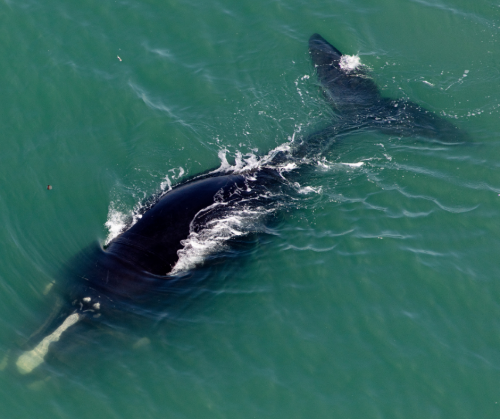 According to a recent study, the endangered North Atlantic right whale is 3 feet shorter than it was 20 years ago, posing fertility and nursing challenges for the species and threatening the number of surviving whales. The study found three key reasons for this difference: climate change, ship collisions and fishing gear entanglements.
According to a recent study, the endangered North Atlantic right whale is 3 feet shorter than it was 20 years ago, posing fertility and nursing challenges for the species and threatening the number of surviving whales. The study found three key reasons for this difference: climate change, ship collisions and fishing gear entanglements.- A recent study has declared the population of pillar coral on the Florida reef to be functionally extinct, meaning the reduced population no longer plays a significant role in the functioning of the ecosystem. But, with efforts to spawn pillar coral in the lab at the Florida Aquarium, scientists say the species may have a chance to make a comeback in the wild. Meanwhile, stony coral tissue loss disease continues to sweep through Florida, devastating populations of stony coral, a key reef-building species. However, a new study shows that treating the reef with amoxicillin – a common antibiotic – may help curb the spread of the disease, though the long-term effects are still unknown.
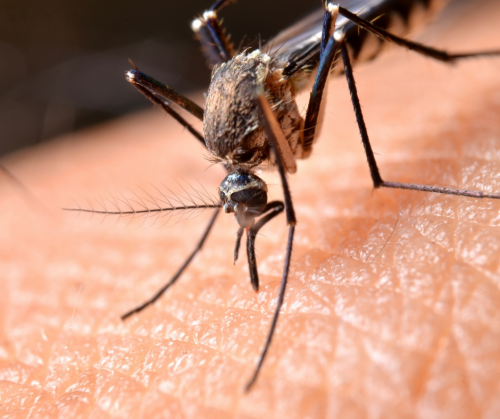 Genetically modified (GM) mosquitos released in the Florida Keys in order to shrink local mosquito populations have reached mating age. Male Aedes aegypti were modified by biotech company Oxitec to hinder female development, meaning female larvae should not survive long enough to reach adulthood. Researchers also believe breeding the GM populations with local populations may eventually lead to decreased pesticide resistance. This short-term experiment marks the first of its kind in the U.S. In Florida, mosquito control is important due to the fact that they can spread diseases, like the Zika virus. A recent study has highlighted the importance of climate variation and seasonality on the transmission and control of the virus. Through their research, the scientists created a model that can predict the size of Zika outbreaks throughout different climates.
Genetically modified (GM) mosquitos released in the Florida Keys in order to shrink local mosquito populations have reached mating age. Male Aedes aegypti were modified by biotech company Oxitec to hinder female development, meaning female larvae should not survive long enough to reach adulthood. Researchers also believe breeding the GM populations with local populations may eventually lead to decreased pesticide resistance. This short-term experiment marks the first of its kind in the U.S. In Florida, mosquito control is important due to the fact that they can spread diseases, like the Zika virus. A recent study has highlighted the importance of climate variation and seasonality on the transmission and control of the virus. Through their research, the scientists created a model that can predict the size of Zika outbreaks throughout different climates.- As part of an attempt to revive the Apalachicola Bay oyster fishery, an experiment is underway to recover oyster populations in the area. Researchers are using oyster shells, small limestone and large limestone to determine which substrate attracts the most oyster larvae to grow into adult oysters. Whichever material proves most successful will be used in larger-scale restoration efforts. The team is also tracking changes in the flow from the Apalachicola River to note what water conditions are best for the oysters. The researchers are hopeful the Apalachicola Bay oyster fishery will be restored in four years’ time.
- With the University of Florida’s new push to use artificial intelligence in scientific research, plant pathologists at the UF Institute of Food and Agricultural Sciences (UF/IFAS) are testing the technology’s ability to detect disease in popular Florida crops, like peanuts and watermelon. The idea is that machines equipped with AI will be able to quickly scan large fields to identify and perhaps even treat a diseased plant before the pathogen spreads.
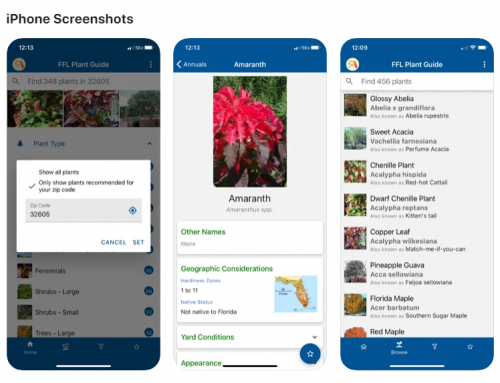 Looking to make your yard more Florida-friendly? There’s an app for that! The UF/IFAS Florida-Friendly Landscaping Program’s new FFL plant guide app will match your yard’s conditions with more than 450 plants so you can find the best ones that work with your landscape. The app is available in the Google Play and Apple app stores.
Looking to make your yard more Florida-friendly? There’s an app for that! The UF/IFAS Florida-Friendly Landscaping Program’s new FFL plant guide app will match your yard’s conditions with more than 450 plants so you can find the best ones that work with your landscape. The app is available in the Google Play and Apple app stores.- Researchers at the Florida Museum of Natural History have discovered the first nest of the rare blue calamintha bee in the Ocala National Forest. The discovery will help conservation and land managers decide whether the bee should be protected under the Endangered Species Act.
- The health, breeding and survival status of the American crocodile are important for helping scientists understand the current status of the Everglades and whether current restoration strategies are working. UF/IFAS researchers have mapped the population changes of the American crocodile over the past 40 years in response to environmental changes in the Everglades. The findings show that increased salinity can have an impact on their survival. However, the researchers say that as restoration projects aimed at directing more freshwater into the Everglades are implemented, they expect to see improvements.
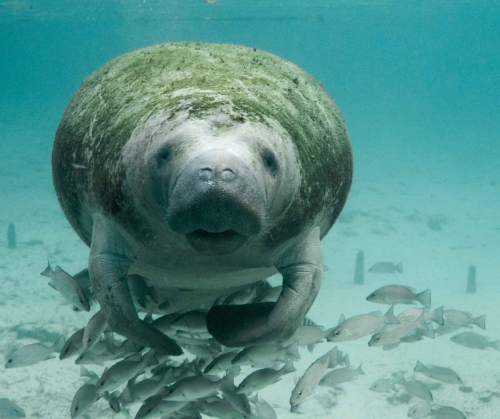 More than 700 manatees have died so far this year; that’s double the average on any given year, causing federal officials to declare it an unusual mortality event. According to the Florida Fish and Wildlife Conservation Commission, reduced supply of the animals’ main dietary staple — seagrass — is to blame, especially in the Indian River Lagoon. Since 2009, the lagoon has lost 46,000 acres of seagrass due to environmental degradation and algal blooms. Likewise, Tampa Bay has lost 13% of its seagrass since 2019. Rep. Tyler Sirois is planning to introduce legislation next session to restore seagrass in the area.
More than 700 manatees have died so far this year; that’s double the average on any given year, causing federal officials to declare it an unusual mortality event. According to the Florida Fish and Wildlife Conservation Commission, reduced supply of the animals’ main dietary staple — seagrass — is to blame, especially in the Indian River Lagoon. Since 2009, the lagoon has lost 46,000 acres of seagrass due to environmental degradation and algal blooms. Likewise, Tampa Bay has lost 13% of its seagrass since 2019. Rep. Tyler Sirois is planning to introduce legislation next session to restore seagrass in the area.- Florida Department of Environmental Protection Secretary Noah Valenstein has stepped down from his position after a four-year term under two governors. In his place, the state agency’s deputy secretary for land and recreation, Shawn Hamilton, will serve as the interim environmental secretary. Hamilton has previously worked as the Environmental Protection Agency’s environmental justice coordinator and has worked on recovery efforts for large-scale natural and industrial emergencies such as the Deepwater Horizon oil spill.
- An effort titled FL5.org aims to add five conservation amendments in the state’s constitution in 2022. The group is currently working to gather 900,000 signatures for a proposed “Rights of Nature” amendment. If passed, the amendment would recognize that all Floridians have a legal right to clean water and would recognize the legal rights of waterways across the state. The other proposed amendments look to increase protection of Florida’s iconic species, ban captive wildlife hunting, increase protections for wetlands and prohibit construction of toll roads on conservation and rural lands.
- Hurricane season had an early start for the seventh year in a row, with subtropical storm Ana forming one week before the official June 1 start date. The National Oceanic and Atmospheric Administration has predicted an “above normal” forecast for the season. Despite this news, a recent survey shows that Floridians are not as worried as they were last year, with only 73% of participants expressing concern — down from 91% last year. Though 2020 was a record-breaking year for hurricanes nationally, the impacts on Florida were minimal in comparison to years prior. Officials in southwest Florida are urging Floridians to not become complacent and to prepare early. A plethora of resources are available to help with planning, including a list of hurricane myths from the Tampa Bay Times and a video from UF/IFAS Escambia County regarding legal responsibilities in the event of damaged trees and fences.
- In coastal South Florida, sea level rise continues to be a pressing issue. With awareness increasing, realtors say that elevation is an important factor for home buyers to consider, especially as projections for sea level rise and flooding indicate that the problems will only get worse around the state. The Flagami neighborhood of Miami has suffered from increased flooding, but it is the last in line to receive fixes from Miami’s $3.8 billion stormwater plan. Even during short rainstorms, the flooding can reach car door handles, ruin homes and prevent children from attending school. And in Sarasota and Manatee counties, a new citizen science initiative aims to document king tides with photos in order to help scientists better understand the impact of sea level rise on coastal communities. Comparison photos of king tides can show how sea level rise can cause the tides to reach higher and extend further over time.
- A recent study that calculates the human cost of climate change shows that human-caused global warming is responsible for more than one-third of global heat deaths each year. The researchers reviewed heat deaths in 732 cities across the globe from 1991 to 2018. Most affected were cities in South America: Sao Paulo, Brazil, has had the most climate-related heat deaths, averaging 239 a year. In the U.S., 35% of heat deaths can be attributed to climate change, with more than 1,100 deaths a year across 200 cities.
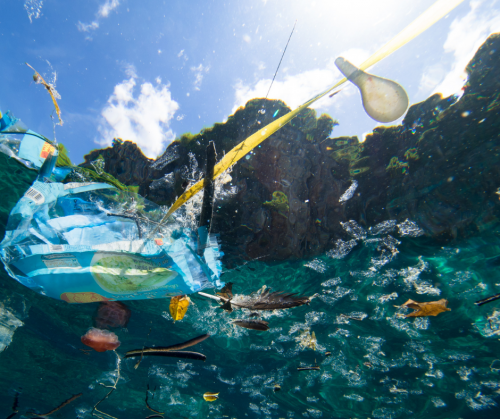 Hundreds of billions of pounds of single-use plastics are thrown away, burned or littered every year. A new study discovered that more than half of the world’s plastic is manufactured by only 20 companies – and the top 100 polymer-producing companies account for more than 90%. These materials can create microplastics, which are tiny, non-degradable pieces of plastic that pollute land, waterways and air. Florida State University researchers studied what happens when this microscopic pollution is inhaled: They found that exposure can hinder the metabolism and growth of human lung cells, change their shapes and create gaps in solid sheets of cells.
Hundreds of billions of pounds of single-use plastics are thrown away, burned or littered every year. A new study discovered that more than half of the world’s plastic is manufactured by only 20 companies – and the top 100 polymer-producing companies account for more than 90%. These materials can create microplastics, which are tiny, non-degradable pieces of plastic that pollute land, waterways and air. Florida State University researchers studied what happens when this microscopic pollution is inhaled: They found that exposure can hinder the metabolism and growth of human lung cells, change their shapes and create gaps in solid sheets of cells.
Sign up for our monthly student-produced Earth to Florida newsletter to get updates like these along with educational content delivered right to your inbox: www.bit.ly/EarthtoFL